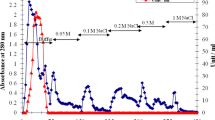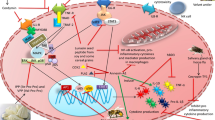Abstract
Bee vemon (BV) is used in folk medicine to treat arthritis. It has antiinflammatory effects in animal models of rheumatic disease. We have studied the effects of BV on human neutrophil production of superoxide (O2 −) and hydrogen peroxide, finding potent, nontoxic, dose-dependent production inhibition. Melittin, the major fraction of BV (50–70%) shows high-affinity calmodulin binding Kd 3 nM). Drugs which bind calmodulin, such as trifluoperazine, inhibit O2 − production by human neutrophils. For these reasons we have investigated the effect of melittin and other BV peptides on O2 − production by human peripheral blood leukocytes. We show that melittin inhibited O2 − production both pre- and poststimulation in contrast to other BV fractions which were without effect. Oxygen radicals and their derivatives from inflammatory cells are implicated in the tissue damage occurring during inflammation. The inhibition is due to a direct effect on cells, and not indicator medium, dismutation, toxic or scavenging effects. We propose that melittin may serve as a prototype small (mol wt 1280), cationic, amphipathic, calmodulin-binding, membrane-active, superoxide-production-inhibiting peptide, providing a model for peptides which could have a role in in vivo regulation of radical production.
Similar content being viewed by others
References
Beck, B. 1935. Bee Venom Therapy. Appleton-Century Company, New York.
Yoirish, N. 1977. The Curative Properties of Honey and Bee Venom. New Glide Publications, San Francisco.
Chang, Y. H., andM. L. Bliven. 1979. Antiarthritic effect of bee venom.Agents Actions 9:205–211.
Lorenzetti, O. J., B. Fortenberry, andE. Busby. 1972. Influence of bee venom in the adjuvant induced arthritic rat model.Res. Commun. Chem. Pathol. Pharmacol 4:399–352.
Lockshin, M. D. 1981. Special article. The unproven remedies committee.Arthritis Rheum. 24:1188–1190.
McCord, J. M., K. Wong, S. H. Stokes, W. F. Petrone, andD. English. 1980. Superoxide and inflammation: A mechanism for the antiinflammatory activity of superoxide dismutase.Acta Physiol. Scand. Suppl. 494:25–30.
McCord, J. M. andK. Wong. 1979. Phagocyte production free radicals: Roles in cytotoxicity and inflammation.Ciba Found. Symp. 65:343–369.
Somerfield, S. D., J. L. Stach, C. Mraz, F. Gervais, andE. Skamene. 1984. Bee venom inhibits superoxide production by human neutrophils.Inflammation 8, (4):385–391.
Singal, P. K., N. Kapur, andK. S. Dhillon. 1982. Role of free radicals in catecholamine-induced cardiomyopathy.Can. J. Physiol. Pharmacol. 60:1390–1387.
Donaldson, J., D. McGregor, andF. La Bella. 1982. Manganese Neurotoxicity: A model for free radical-mediated neurodegeneration.Can. J. Physiol. Pharmacol. 9:443–445.
Butterfield, J. D., andC. P. McGraw. 1978. Free radical pathology.Stroke 9:443–445.
Demopoulos, H. B., E. S. Flamm, andD. D. Pietronigro. 1980. The free radical pathology and the microcirculation in the major central nervous system disorders.Acta Physiol. Scand. Suppl. 492:91–119.
Lunec, J., S. P. Halloran, R. G. White, andT. L. Dormandy. 1981. Free radical oxidation (peroxidation) products in serum and synovial fluid in rheumatoid arthritis.J. Rheumatol. 8:233–245.
McCord, J. M. 1974. Free radicals and inflammation: Protection of synovial fluid by superoxide dismutase.Science 185:529–531.
Hyrst, N. P., B. Bessac, andG. Nuki. 1984. Monocyte superoxide anion production in rheumatoid arthritis: Preliminary evidence for enhanced rates of superoxide anion production by monocytes from patients receiving penicillamine, sodium aurothiomalate, and corticosteroids.Ann. Rheum. Dis. 43:28–33.
Ferrante, A., andY. H. Thong. 1980. Optimal conditions for simultaneous purification of mononuclear and polymorphonuclear leukocytes from human peripheral blood by HypaqueFicoll method.J. Immunol. Methods 36:109–117.
Benton, A. W., R. A. Morse, andJ. D. Stewart. 1963. Venom collection from honey bees.Science 142:228–230.
Bobik, A., J. Campbell, P. Snow, andP. J. Little. 1983. The effects of endogenous phospholipase A2 activation on beta adrenoceptor function in cardiac cells.J. Mol. Cell. Cardiol. 15:759–768.
Cohen, H. J., andM. E. Chovaniec. 1978. Superoxide generation by digitonin stimulated guinea pig granulocytes. A basis for a continuous assay monitoring superoxide production and for the study of the activation of the generating system.J. Clin. Invest. 61:1081–1087.
Fridovich, I. 1970. Quantitative aspects of the production of superoxide anion radical by milk xanthine oxidase.J. Biol. Chem. 215:4053–4057.
Takeshige, K., andS. Minakami. 1981. Involvement of calmodulin in phagocytic respiratory burst of leukocytes.Biochem. Biophys. Res. Commun. 99:484–490.
Smith, R. J., B. J. Bowman, andS. S. Iden. 1981. Effects of trifluoperazine on human neutrophil function.Immunology 44:677–684.
Smolen, J. E. andG. Weissmann. 1981. The roles of extracellular and intracellular calcium in lysosomal enzyme release and superoxide anion generation by human polymorphonuclear leukocytes.Biochim. Biophys. Acta 677:512–520.
Menander-Huber, K. B. 1980. Double-blind controlled clinical trials in man with bovine copper-zinc superoxide dismutase (Orgotein).In Biological and Clinical Aspects of superoxide and superoxide Dismutase. W. H. Bannister, J. V. Bannister, editors. Elsevier/North Holland, Amsterdam. 408–423.
Comte, M., Y. Maulet, andJ. A. Cox, 1983. Ca2+-dependent high-affinity complex formation between calmodulin and melittin.Biochem. J. 209:269–272.
Barbior, B. M. 1984. The respiratory burst of phagocytes.J. Clin. Invest. 73:599–601.
Katoh, N., R. L. Raynor, B. C. Wise, R. C. Schatzman, R. S. Turner, D. M. Helfman, J. N. Fain, andJ. Kuo 1982. Inhibition by melittin of phospholipid-sensitive and calmodulinsensitive Ca2+ -dependent protein kinases.Biochem. J. 202:217–224.
Mori, T., Y. Takai, R. Minakuchi, B. Yu, andY. Nishizuka. 1980. Inhibitory action of chlorpromazine, dibucaine and other phospholipid-interacting drugs on calcium-activated, phospholipid-dependent protein kinases.J. Biol Chem. 255:8378–8380.
Jones, H. P., G. Chai, W. F. Petrone, andJ. M. McCord. 1982. Calmodulin-dependent stimulation of the NADPH oxidase of human neutrophils.Biochim. Biophys. Acta 714:152–156.
MacNeil, S., S. W. Walker, B. L. Brown, andS. Tomlinson. 1982. Evidence that calmodulin may be involved in phytohaemagglutinin-stimulated lymphocyte division.Biosci. Rep. 2:891–897.
Castagna, M., Y. Takai, K. Kaibucht, K. Sano, U. Kikkawa, andY. Nishizuka. 1982. Direct activation of calcium activated phospholipid-dependent protein kinase by tumour producing phorbol esters.J. Biol. Chem. 257:7847–7851.
Author information
Authors and Affiliations
Additional information
Supported by grants from the Medical Research Council of Canada (No. 6431), Arthritis Society of Canada (No. 5-261-83), Arthritis Foundation of New Zealand and Rose Hellaby Trust.
Rights and permissions
About this article
Cite this article
Somerfield, S.D., Stach, J.L., Mraz, C. et al. Bee venom melittin blocks neutrophil O2 − production. Inflammation 10, 175–182 (1986). https://doi.org/10.1007/BF00915999
Issue Date:
DOI: https://doi.org/10.1007/BF00915999




